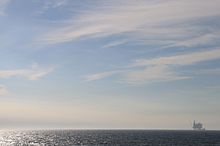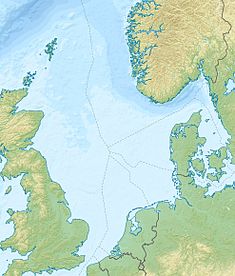Grane (Norwegian: Granefeltet) is an offshore oil field in the North Sea located 185 km (115 mi) west of the city of Haugesund on the western coast of Norway.[1] It is Norway's first heavy crude oil production field and Statoil's largest heavy oil field in the Norwegian continental shelf. The oil from the field, located in Block 25/11 is transported to Sture terminal via Grane oil pipeline.[2] The injection gas is imported to Grane oil field from the Heimdal, located just north the field.[3][4]
| Grane | |
|---|---|
| Country | Norway |
| Offshore/onshore | Offshore |
| Coordinates | 59°13′N 2°29′E / 59.22°N 2.49°E |
| Operator | Statoil |
| Partners | Statoil (38%) Petoro (30%) ExxonMobil (25.60%) ConocoPhillips (6.40%) |
| Field history | |
| Discovery | 1991 |
| Start of production | 2003 |
| Peak of production | 10 March 2006 |
| Abandonment | 2020 |
| Production | |
| Current production of oil | 34,000 m3/d (210,000 bbl/d) |
| Producing formations | Heimdal, Lista |

Ownership
editThe Grane field is operated by Statoil, with Statoil holding 38% of the stake, Petoro – 30%, ExxonMobil – 25.60%, and ConocoPhillips – 6.40%.[2][5]
Technical features
editThe field lies in 128 metres (420 ft) of water at total depth of 1,700 metres (5,600 ft). The reservoir is nearly 27 square kilometres (10 sq mi) and has an average pay thickness of 50 metres (160 ft) with an average porosity of 33% and permeability of 5–10 Darcies.[4] The reservoir consists of sandstones of Heimdal formation of Paleocene age, Lista Formation and has high viscosity.[6]
Development history
editNorsk Hydro and partners started development of the field in 1991.[2] The Grane field started producing in September 2003. 31 production wells were put into operation.[7] The facility was designed by Aker Solutions Engineering in 2000–2003.
Production
editAt Grane oil field, Norsk Hydro used the technology applied at its Troll and Oseberg fields to maximize production in Grane. An estimated 700 million barrels (110×106 m3) is expected to be produced by the field with 214 thousand barrels per day (34.0×103 m3/d). With the first horizontal well drilled, Hydro already reached a peak production by 10 March 2006 setting a record at 243 thousand barrels per day (38.6×103 m3/d) which exceeded the initially established field plan by about 30 thousand barrels (4.8×103 m3). From then on, the field supplied the market an average 220 thousand barrels per day (35×103 m3/d).[7] The company expects 55% recovery from the field. This makes Grane third of the size of Oseberg and twice the size of Brage. There is no gas cap in Grane field.[4]
The production profile of the Grane field (in million Sm3 oil equivalent) is as follows.[8]
| Year | Production |
|---|---|
| 2003 | 0.751066 |
| 2004 | 7.086147 |
| 2005 | 10.307771 |
| 2006 | 12.613752 |
| 2007 | 11.992443 |
| 2008 | 10.037249 |
| 2009 | 10.723929 |
| 2010 | 9.654461 |
| 2011 | 8.097365 |
| 2012 | 7.108406 |
| 2013 | 5.504911 |
| 2014 | 4.085547 |
| 2015 | 4.214624 |
| 2016 | 4.391 |
| 2017 | 5.832353 |
| 2018 | 5.62534 |
| 2019 | 5.118285 |
| 2020 | 3.986892 |
| 2021 | 3.063436 |
| 2022 | 2.102059 |
| 2023 | 2.04668 |
See also
editReferences
edit- ^ "List of Subsea Oil Gas Projects Offshore Europe(North)". Subsea.org. Retrieved 24 April 2011.
- ^ a b c "Subsea Oil & Gas Directory". Subsea.org. Retrieved 24 April 2011.
- ^ "Statoil.Operations North Sea". Statoil.com. Retrieved 24 April 2011.
- ^ a b c Lyle, Don (January 2007). "Grane gives up heavy Norway oil". E&P Magazine. Retrieved 7 December 2009.
- ^ "ConocoPhillips data". Conocophillips.com. Retrieved 24 April 2011.
- ^ "OLJEDIREKTORATET Norwegian Petroleum Directorate. Grane". Npd.no. Archived from the original on 16 February 2006. Retrieved 24 April 2011.
- ^ a b "Grane oil field success at OTC". Hydro News. 3 May 2006. Archived from the original on 8 January 2009. Retrieved 7 December 2009.
- ^ Norsk Petroleum. "Grane oil field". Retrieved 14 July 2024.
